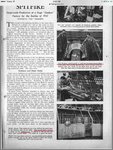Here is a couple of images of the the rear interior I found via the net. Not of too good quality but it can be noticed that there were two stringers at least. These two running back can be seen at the top of the compartment. According to the diagram there these run up to the tail whiil section. The diagram dosn't show it clearly but there were two more running at the floor level, also the floor there was the reinforcement of the section too. All of the stringers were becoming thinner going farther back what is a correct way of getting tappered stringers for the proper structural strength. The side "longerons" were a kind of stringers in fact that made the structural strength of the tail section with a couple of additional stiffeners and longerons. So it seems that the diagram posted by Koopernic is a little bit inaccurate with the riveting layout.

Last edited:

